If you have a secret recipe or an article perfect for sharing on our blog section, don't hesitate to let us know at [email protected] -- everyone has something extraordinary to offer and we can't wait to hear yours! Join us as we explore delicious flavors around the globe!
For now, love yourself and enjoy this one ...
Now love yourself and enjoy this one ...
This mouthwatering dish proves that simple ingredients can transform mundane meat into a masterpiece!
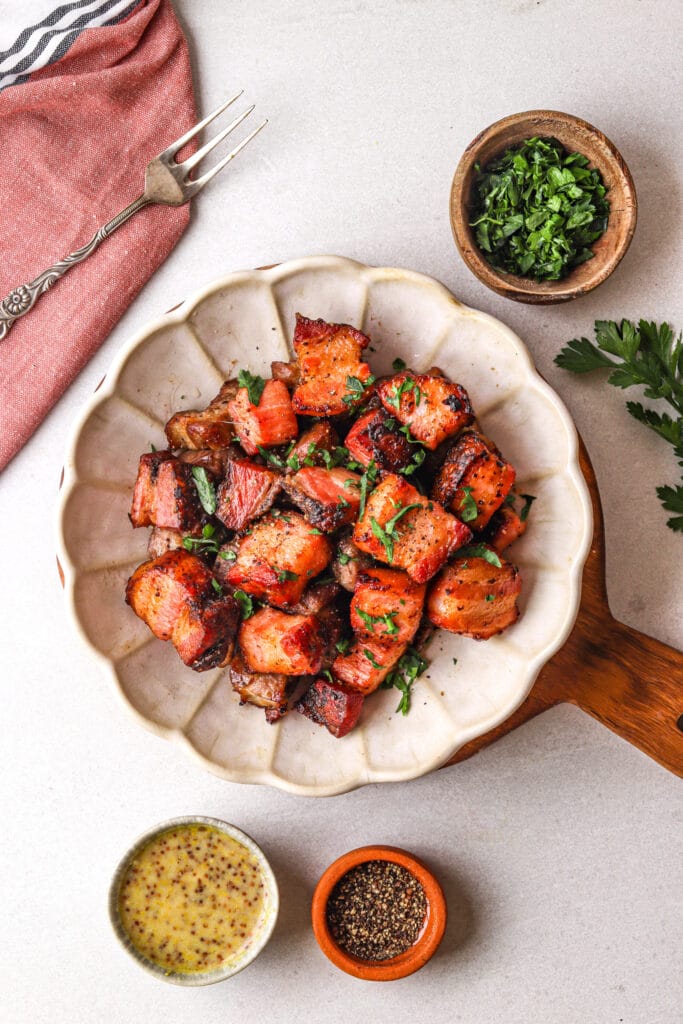
Pork belly has been an underappreciated meat in America, but not anymore. I swear, every time I go out to eat, this delightful meat keeps turning up on the menus. And you know how I know that pork belly is getting popular? The price! While it’s still cheaper than more expensive cuts, pork belly isn’t a bargain buy anymore. It’s officially reached trend status, and I’m so there for it.
If you haven’t tried pork belly, you’re in for a treat, and no, it doesn’t taste like bacon. Thanks to its high fat content, this meat cooks to perfection in the air fryer, with a crispy exterior and a juicy, tender interior. This recipe balances sweet and savory with a mixture of maple syrup, garlic powder, and a bit of salt and pepper. Feel free to add your own favorite spices!
Is Pork Belly Healthy?
Yes, pork belly has a lot of fat. Like a lot of fat. But pork belly, especially if you buy local, organically raised pork, is surprisingly nutritious. Organic pork contains an abundance of B vitamins as well as vitamin E and selenium, both of which boast cancer fighting and anti-aging benefits. Now, I bet you’re wondering about all that fat. Well, pork belly is an excellent source of monounsaturated fats and omega-3, you know, the good fats. Monounsaturated fats are what you find in olive and avocado oils. I’m not saying you should eat pork belly every day, but if you choose organic, pasture-raised pork, there’s no shortage of nutrients. And this goes without saying, but I’ll say it for the kids in the back—pork belly is paleo and keto friendly.
What is Pork Belly, and Where Can I Find It?
Pork belly is one of the most popular meats worldwide, and it’s growing in popularity in America, too. But what is it exactly? Basically, it’s a cut that comes from the pig’s underside. That’s why it’s such a fatty cut of meat, which also makes it perfect for air fryer recipes. The air fryer’s heat circulation puts that fat to good use by rendering it out slowly, allowing the meat to become crispy on the outside while remaining tender and juicy on the inside.
These days, it’s pretty easy to find pork belly at your grocery store’s butcher section. Personally, I like to visit my local butcher, who carries a great selection of organic, pasture raised meats. If you can, buy local and organic. Pasture raised pork belly is generally more nutritious, and I think it tastes better.
INGREDIENTS
- 1 ½ pounds pork belly (cut into 1-inch pieces)
- 3 tablespoons avocado oil
- 1 tablespoon maple syrup
- 1 teaspoon garlic powder
- 1 teaspoon kosher salt
- 1 teaspoon black pepper
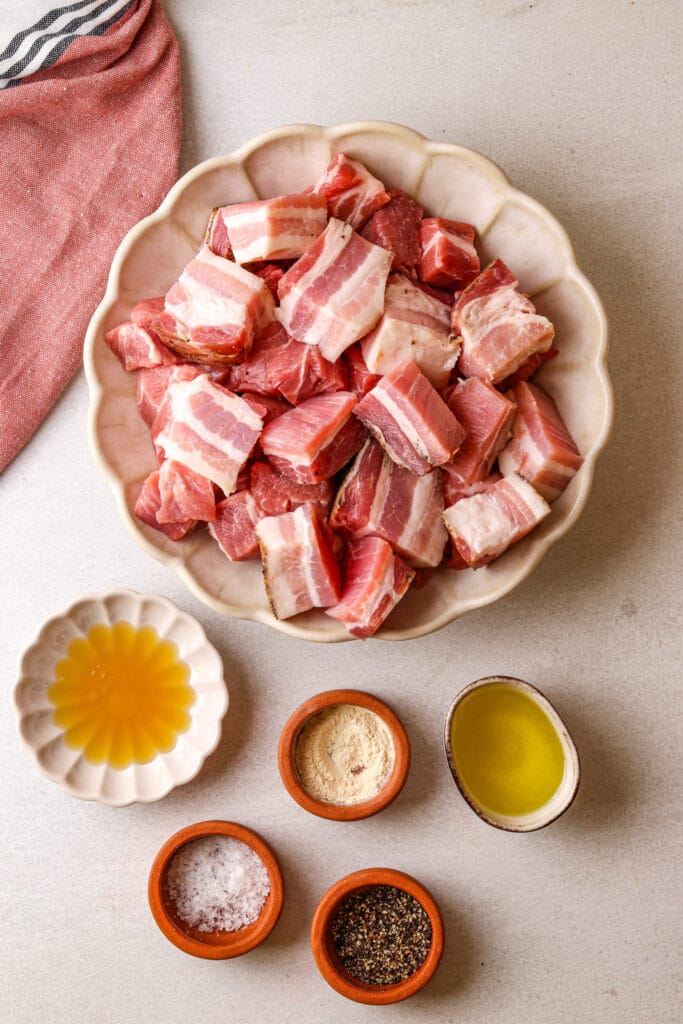
INSTRUCTIONS
Preheat
Get the air fryer heated up to the right temperature for cooking the pork belly bites.
Mix
Create a flavorful coating with avocado oil, maple syrup, and spices in a bowl.
Coat
Toss the pork belly pieces in the seasoning mix until they’re well covered.
Arrange
Place the pork belly bites in the air fryer basket in a single layer for even cooking.
Cook
Air fry the pork belly, shaking the basket periodically for a uniform golden crisp.
Rest
Let the cooked pork belly bites cool slightly before serving to enhance their texture.
Serve
Enjoy the deliciously crispy pork belly bites fresh from the air fryer.
Devour!
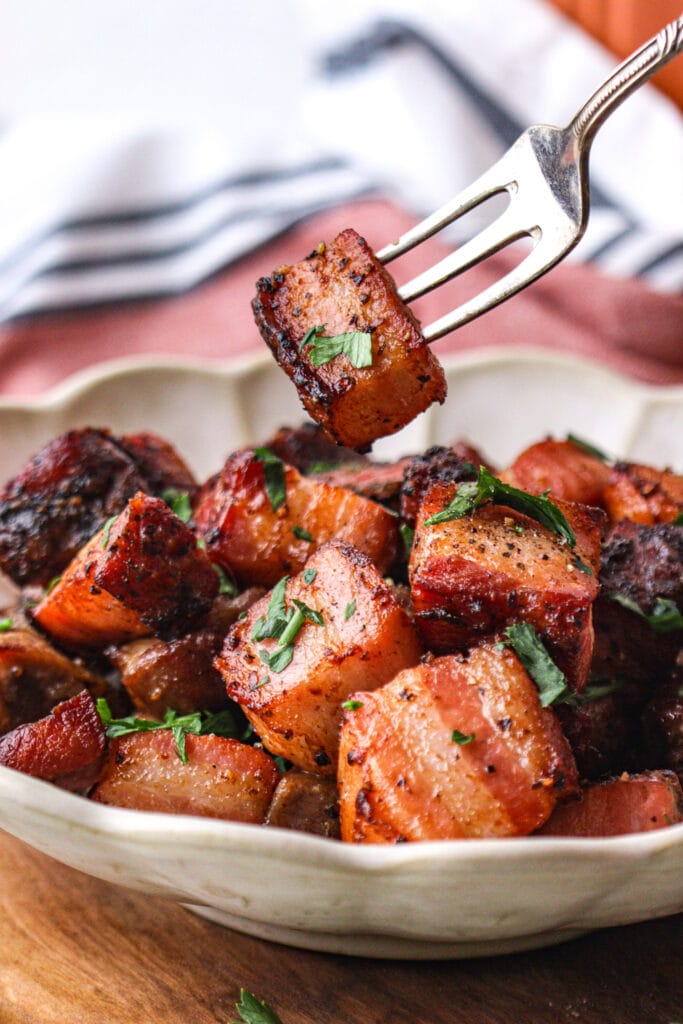
FAQs & Tips
Pork belly makes good leftovers and even tastes delicious cold—try it on your salad! As long as you store it in an airtight container, this dish should last about five days in the fridge.
Too much moisture will steam the skin rather than crisp it. So, if the skin feels too wet, I recommend drying the pork belly skin with a paper towel.
You could. In fact, cubing the pork belly and then leaving it in the fridge overnight will ensure your meat gets even crispier in the air fryer. All you need to do is pat the meat dry and rub salt all over it.
Of course! Air fryers aren’t universal, so you may need to tweak the temperature and duration of this recipe. Whether you adjust anything are not, I’d still advise you to check on your meat every few minutes.
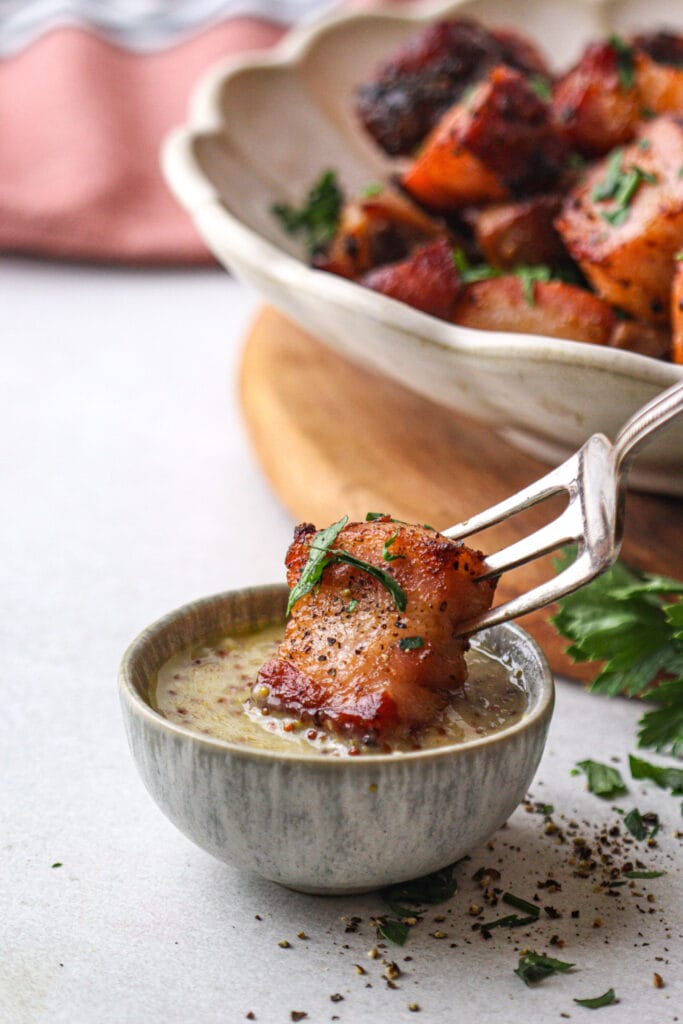
Serving Suggestions
I love dipping the air fried pork belly in a chipotle or mustard sauce. The contrasting flavors are just delightful. But you need more than just dipping sauces. I consider this pork belly a comfort food, and that means I need some comfort food side dishes like mashed potatoes and corn on the cob. Add a side of asparagus, and you have yourself a hearty and healthy meal.
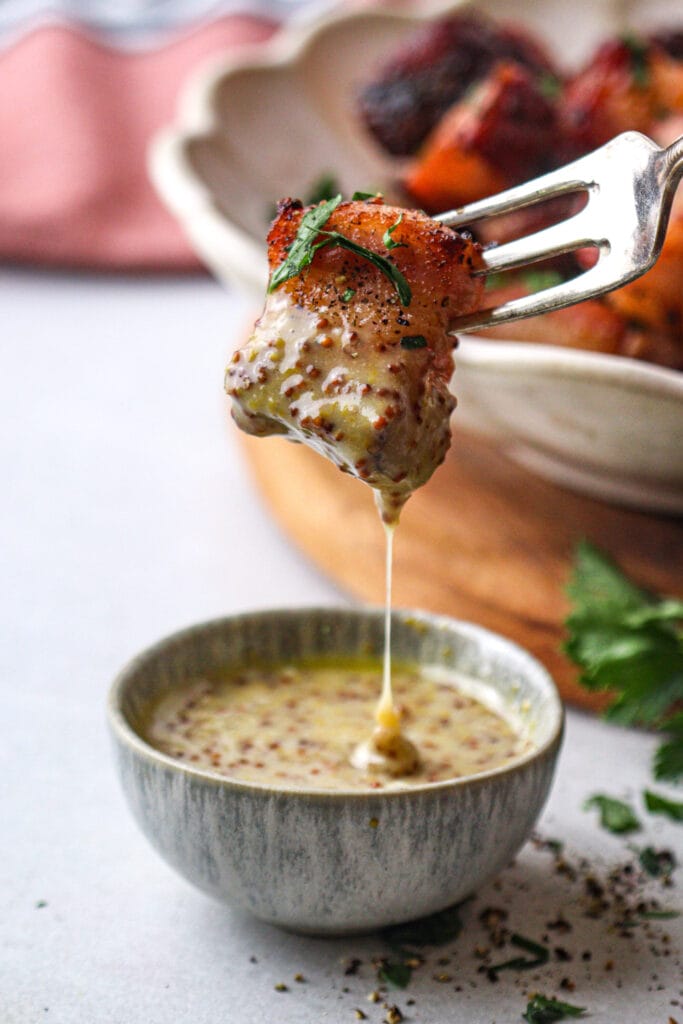

Air Fryer Pork Belly Bites
Ingredients
- 1 ½ pounds pork belly cut into 1-inch pieces
- 3 tablespoons avocado oil
- 1 tablespoon maple syrup
- 1 teaspoon garlic powder
- 1 teaspoon kosher salt
- 1 teaspoon black pepper
Instructions
- Preheat the air fryer to 400°F. Ensure the air fryer is ready to cook for even, crispy results.
- In a large bowl, whisk together the avocado oil, maple syrup, garlic powder, salt, and pepper until well combined.

- Toss the pork belly pieces in the oil mixture until each piece is evenly coated with the seasoning.
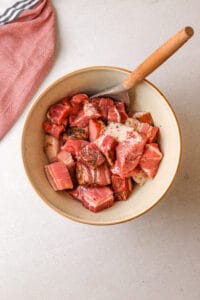
- Arrange the pork belly pieces in a single layer in the air fryer basket, ensuring they are not overcrowded for optimal air circulation.

- Cook the pork belly in the air fryer for 18-20 minutes, shaking the basket every 5 minutes to promote even cooking and crispiness.
- Once the pork belly bites are golden brown and crispy, carefully remove them from the air fryer and let them rest for a few minutes before serving.
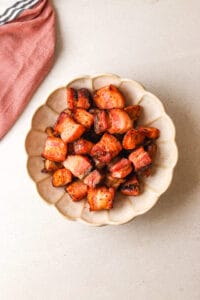
- DEVOUR!
Nutrition
The post Air Fryer Pork Belly appeared first on Food Faith Fitness.
References:
By: FoodfaithfitnessTitle: Air Fryer Pork Belly
Sourced From: www.foodfaithfitness.com/pork-belly-air-fryer/
Published Date: Fri, 15 Mar 2024 15:57:05 +0000
Frequently Asked Questions
Does organic mean that it is not sprayed with pesticides?
Organic food is chemical-free and grown without pesticides. This means organic food is free from pesticides and fertilizers.
Organic produce also contains more nutrients than conventionally produced foods because it contains no harmful additives.
The USDA National Organic Program (NOP), requires that farmers follow strict guidelines when growing organic crops.
These guidelines include soil preparation, crop rotation, pest control, water conservation, and harvesting practices.
Organic farming methods are also beneficial for wildlife and natural habitats.
Why is organic produce important?
It is essential for our health to eat organic produce. It is the best option to ensure that we eat nutritious food. Not only is it better for us, but it's also more environmentally friendly because it doesn't rely on pesticides and fertilizers.
Organic farming uses natural methods of cultivating crops that are free from harmful chemicals. This results in fewer environmental pollutants and makes organic farming safer. By choosing organic food, you are protecting the planet as well as yourself.
However, organic food is good for our health. We all know the negative effects that processed foods can have on our health. You might not know this, but organic fruits and vegetables don't have to be treated with chemicals. This means they are more fresh tasting, last longer and look better.
That's why eating organic matters so much. Organic food is not only healthier for you but also for the whole world.
What is organic?
Organic meat is food that has not been treated with pesticides or artificial fertilizers. Organic meat is also a guarantee that the animals weren’t fed any genetically altered feed. It is safe to eat because it doesn't contain any harmful chemicals.
Organic meats are also healthier for the environment. We reduce the amount of pollution in our rivers, lakes, and landfills by eating organic food. We can also help wildlife by eating organic foods. Organic farmers do not often use toxic chemicals that can kill birds or insects.
The best way to ensure that you eat healthy organic meats is to buy them locally whenever possible. Buying local helps keep more money circulating within the community rather than going out of state. Local businesses often pass down savings to customers when they shop locally. Shopping locally keeps American jobs in America, rather than sending them abroad.
What is the difference between organic and inorganic foods?
Organic food is produced without pesticides, chemical fertilizers, sewage sludge, irradiation, or genetic modification. Organic farming practices support soil health, water quality, and animal welfare.
Inorganic foods are grown with pesticides, chemical fertilizers, and sewage sludge. Radiated foods are those that have been exposed to radiation. Genetically modified organisms, or GMOs, are created using biological engineering techniques.
The term "natural" is often used interchangeably with "organic." However, natural does not necessarily mean organic. Natural products can also be labeled with synthetic ingredients.
Organic produce is often more nutritious than conventional produce, as the soil has fewer pesticides and harmful chemicals. In addition, organic farmers do not use artificial fertilizers, hormones, antibiotics, or pesticides.
What should I be looking out for when shopping organic products
Look for USDA-certified organic labels. This guarantee that the product has met specific standards set forth by USDA. You will find the USDA Organic seal on all boxes, cartons and cans.
When shopping for meat, ensure it comes from cows fed 100% organic feed. Cattle are ruminants, which means they chew the cud. Ruminant cattle can be found with four stomach compartments: the rumen, the reticulum, omasum, abomasum and omasum. If the cow is to be labeled "100% organic", all of its parts must have been organically fed.
You should only purchase chicken that has been raised organically. It must not have ever been treated with antibiotics. Omnivore chickens eat both animals and plants. Omnivorous chickens have a digestive tract composed of a crop, proventriculus, gizzard, small intestine, large intestine, and anus.
Buy only dairy products from cows that have been fed organically grown feed. Dairy cows have four stomach compartments, just like ruminants. The fourth stomach, or the udder is where you get milk.
When purchasing other types of livestock, check the label to see what percentage of the diet the animals were fed. For example, pork may be labelled '95% organic.' This means 95 percent of the pig's feed came from organic sources.
Are organic meats better?
If you've been paying any attention, you likely already know the answer. Here's the problem: Organic food is becoming more sought-after, while traditional food continues to decline in popularity.
Organic foods continue to be popular because they offer a healthier alternative. Organic foods are also safer for our overall health and reduce pollution.
There are many sides to this coin. Organic produce takes longer to grow, and it requires more resources. This means that organic food costs more money than its non-organic counterpart.
Organic meats will typically be more expensive than those that are raised in conventional conditions. But, you can reduce the cost of organic meats without compromising quality.
Local purchases can help you save money. Locally grown fruits and veggies help to lower prices because farmers get incentives to grow good crops.
Deals are another way to cut costs. You may be able to get discounts when you buy organics.
Another way to save money? Eat less meat. Feeding livestock can be very expensive.
There are many reasons organic foods are better for our bodies and the environment, but we need to be mindful of the cost.
Statistics
- According to a study performed by consumerreports.org, organic products, compared to non-organic products, ranged anywhere from 13 percent cheaper to 303 percent more expensive. (en.wikipedia.org)
- To provide the highest quality products and services to every customer, with a dedicated workforce that puts the customer first and takes the extra step to achieve 100% customer satisfaction and loyalty. (hollinsorganic.com)
- When packaged products indicate they are “made with organic [specific ingredient or food group],” they contain at least 70% organically produced ingredients. (usda.gov)
- Brands participating in this challenge are committed to using 100 percent sustainable cotton by 2025.[5] (en.wikipedia.org)
External Links
[TAG36]
- PubMed Evaluation of the micronutrients in plant foods made by conventional and organic farming methods.
- Comparison of the total ascorbic and phenolic acid contents of air-dried and freeze-dried marionberry, strawberry and corn grown using conventional, organic and sustainable agricultural practices – PubMed
[TAG39]
[TAG42]
- EWG's 2022 Shopper’s Guide to pesticides in produce
- Clean Fifteen (tm) Conventional Produce Using the Least Pesticides
[TAG45]
How To
Are there any disadvantages to purchasing organic products
Organic food has many benefits. There are some downsides to organic food. These include higher prices for consumers, lower quality standards, and fewer options.
There is nothing wrong with wanting more variety in groceries. We have been trained to expect inferior food that tastes bad. That's why you'll find most grocery stores stocked with identical prepackaged products.
Organic food is becoming more popular today because it provides better nutrition and great tasting food. So how do you convince people it's worth paying a little extra?
They could easily tell you that organic food costs more. It doesn't change the fact that organic food tastes more delicious. This might make them suspicious about your motives.
It would be better to highlight its benefits. Organic food is healthier and contains less pesticides, antibiotics, and it has higher nutritional content. Plus, it's grown without synthetic fertilizers and herbicides, which means it's healthier for us and our environment.
Many people turn down organic food simply because it is too costly. However, if they look at the health benefits, organic food may be worth the cost.
Organic food tastes great because it is made according to strict guidelines. Organic food retains more vitamins, minerals and antioxidants.
Organic food is also more delicious because it's harvested later in the season. This makes organic food fresher and easier for you to digest.
Finally, organic food is generally cheaper because farmers grow it organically, which requires less labour and fertilizer.
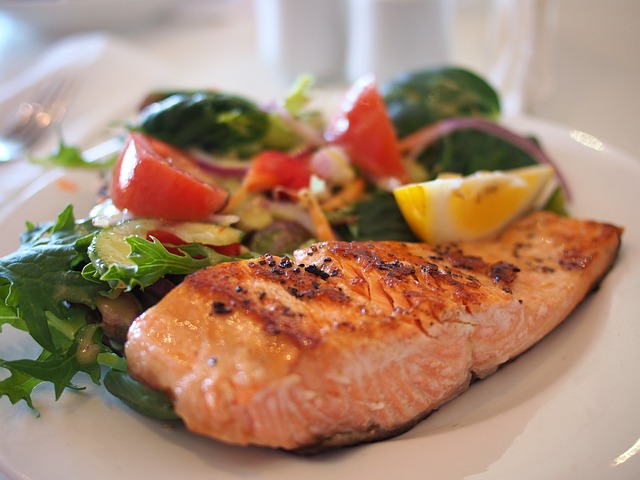 |
[TAG47]This Irish-inspired colcannon soup is easy to make with creamy potatoes, kale and cheddar cheese. The last time I made colcannon (traditional Irish mashed |
 |
[TAG48]This Irish kale colcannon recipe is perfectly buttery and fluffy and easy to make with a handful of basic ingredients. St. Patrick’s Day is just around the |
 |
[TAG49]Easy to make full flavoured recipes. Life is too short for boring food! |
 |
[TAG50]Hello hello! Just wanted to pop in with a cute little life update. ♡ I’m delighted to share that our sweet son, Milo Alexander Martin, came to join our family |
 |
[TAG51]This vibrant lemony broccoli pesto pasta is quick and easy to make and full of fresh flavors. Your veggies, greens, and pasta…all in one gorgeous dish! ♡ We’re |
 |
[TAG52]HEALTHY & KID-FRIENDLY MEALS easy dinner recipes made in minutes. The Latest Recipes st. Patrick's Day Recipes Hello! I'm Sara! Welcome to Dinner at the Zoo! |
 |
[TAG53]This simple roasted carrot soup recipe is made with creamy tahini and topped with crispy za’atar chickpeas. Naturally gluten-free, vegetarian and vegan. If you |
 |
[TAG54]My longtime favorite flourless cake recipe is decadently rich and delicious, naturally gluten-free, and easy to make in under 1 hour! Trust me, this flourless |
 |
[TAG55]From comfort foods to indulgent dishes browse hundreds of recipes that your family will love and make over and over again. Cooking Classy has never been easier, |
 |
[TAG56]This vegetarian cabbage roll soup is filled with protein-rich lentils and all of the delicious flavors you love from traditional cabbage rolls. Naturally |
 |
[TAG57]These zesty roasted sweet potato and chickpea bowls are layered with sautéed spinach and brown rice and tossed with my favorite 4-ingredient chipotle tahini |
 |
[TAG58]A family food blog with hundreds of simple, tested and approved recipes. Find easy step-by-step photo cooking instructions and video recipes. |
 |
[TAG59]This classic matcha latte recipe is easy to make and customize to your liking and always so delicious. The older I get, the more I’m convinced that one of |
 |
[TAG60]This veggie-loaded broccoli cheese soup recipe is perfectly velvety and creamy without using heavy cream. Instant Pot, Crock-Pot and stovetop options all |
 |
[TAG61]find out hundres of delicous food recipes |
 |
[TAG62]This winter farro salad recipe is made with the most delicious blend of seasonal fruit, greens, nuts, crumbled cheese and tossed with a vibrant orange ginger |
 |
[TAG63]This lovely white wine sautéed mushrooms recipe is quick and easy to make, full of rich savory flavors, and can pair well as a side dish with many different |
 |
[TAG64]The food blog with mostly healthy recipes made with real, whole foods inspiring more people to get into the kitchen and cook something good. |
 |
[TAG65]This traditional Swedish meatballs recipe is bursting with rich, savory flavors and topped with a creamy gravy. Always so comforting served over mashed |
 |
[TAG66]This classic Irish coffee recipe is easy to make with 4 ingredients in just a few minutes. Always so warm and cozy! Let’s warm up with a hot mug of Irish |
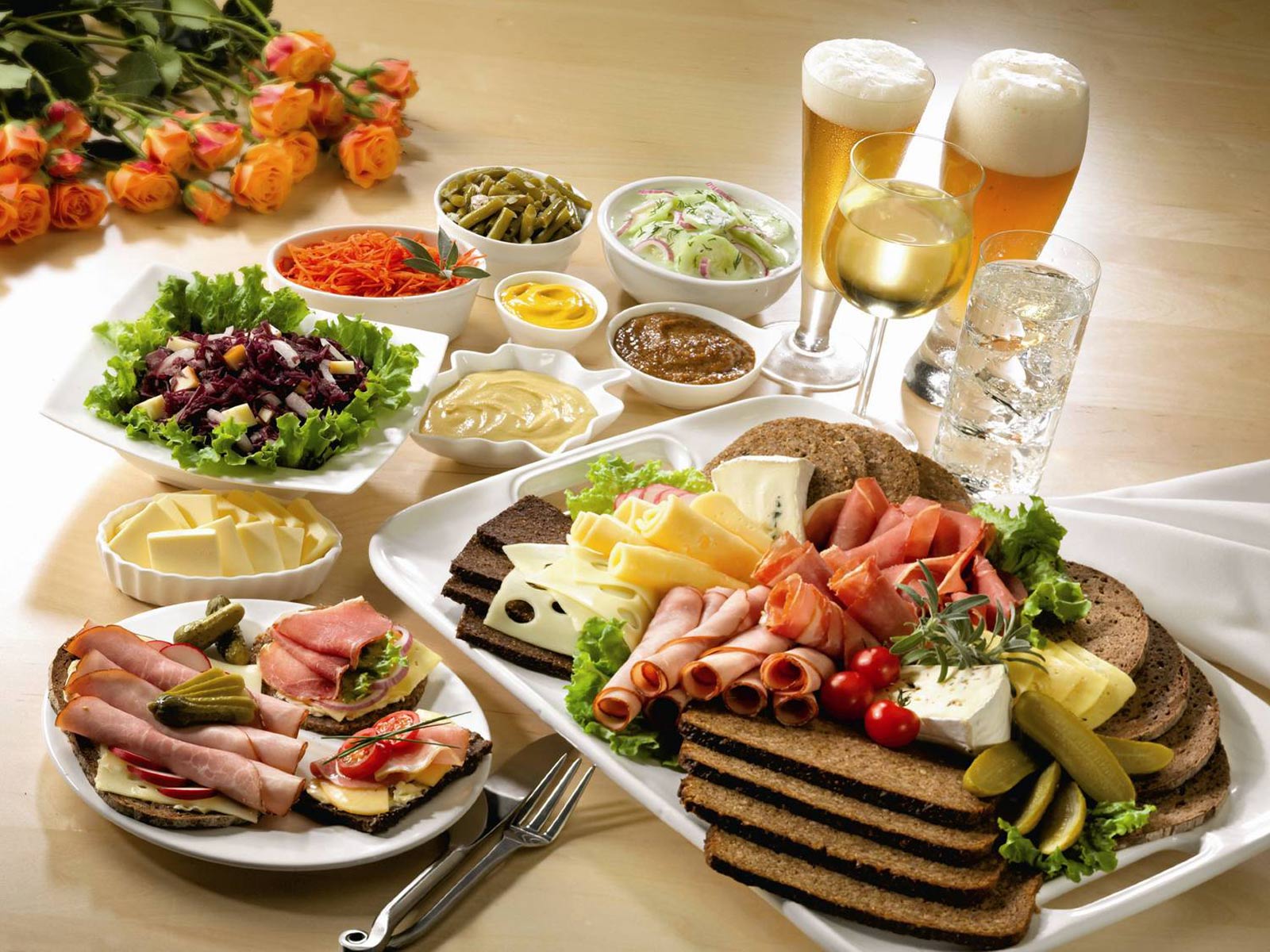 |
[TAG67]A food blog with hundreds of quick and easy dinner recipes. Classics done right, incredible one pot recipes, Asian takeout at home and holiday feasting! |
.png)





